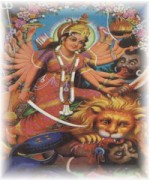 |
 |
|
| NAVRATRI |
|
| Location :
Throughout Gujarat |
|
| Significance :
Worship of Goddess |
|
| In the month
of :
September / October |
|
|
|
| Navratri, meaning 'nine nights', is an ancient
and colourful festival. It honors the one divine 'Shakti' or Force, which
supports the entire universe, and is personified as the Mother Goddess. She
protects her worshippers, destroys evil and grants boons to her children. The
mother Goddess has seven well-known forms, depending upon the special powers
she manifests. Throughout Gujarat, Navratri is celebrated with joy and
religious fevour. |
|
The Festivity
This festival is essentially religious in nature. It is celebrated with true
devotion in the various temples dedicated to the Mother, or 'Mataji', as she is
familiarly called. In some homes, images of the Mother are worshipped in
accordance with accepted practice. This is also true of the temples which
usually have a constant stream of visitors from morning to night, another
interesting feature of Navratri is the Garba, a circular dance performed by
women around an earthen ware pot called a "Garbo", filled with water.
|
 |
|
|
| A betel nit and a silver coin are placed
within the pot, called a "Kumbh", on top of which a coconut has also been
placed. As the dancers whirl around the pot, a singer and a drummer provide the
musical accompaniment. The participants clap in a steady rhythm. |
|
| Nowadays, loudspeakers are used to enhance the
sound, which grows to a crescendo. The dance usually starts slowly. It gets
faster and faster as the music too gets more rapid, until the dance abruptly
comes to a halt. There is a pause for a while and the dance commences once
again, the singer leading with a new song. |
|
Another dance, which is also a feature of
Navaratri, is the "Dandia-Ras" or 'stick' dance, in which men and women join
the dance circle, holding small polished sticks or Dandias. As they whirl to
the intoxicating rhythm of the dance, men and women strike the Dandias
together, adding to the joyous atmosphere.
So popular are the Garba and the Dandia-Ras that competitions are held to
assess the quality of the dancing. Prizes are given to those judged to be the
best. The costume worn for the dances are traditional and alive with colour.
The dances usually commence late in the night and continue until early morning,
testifying to their great popularity. |
|
NAVRATRI AT AHMEDABAD
While the basic celebrations are alive and joyous, as they are elsewhere, at
Ahmedabad the Garba parties are enormous. In large public squares group of
musicians sing the traditional Garba songs. A Bhajan singer with a Harmonium
sings into a microphone. In crowded localities, where open space is not
available, the Garba ceases to be a circular dance but instead becomes a long
line of people, comprising both men and women moving in accordance with the
turns and bends of the street. The scene is truly fantastic.
|
|
NAVRATRI IN BARODA
Baroda is a well-known centre of music and culture, and many streets have their
own Garba Mandals, or Garba groups. A Bhavai performance is held at Baroda's
Ambaji temple, during Navratri. Many other places within Gujarat have their own
local customs ad celebrate Navratri in their own special way
|
|
|
|
|
|
|
|
 |
 |
|
 |
 |
|
 |
 |
|